Canadian Hybridities: when Art and Technology meet
Naples, March 24th 2010 – The speaking tour about Canadian Hybridities began at S.Maria Porta Coeli Building, chaired by Angela Buono and Marina Zito
The first meeting of the course, entitled The rational ethic/aesthetics of the “sense-lab”, was given by Stamatia Portanova, professor at the Media and Cultural Studies Department of the Birkbeck University in London.
The lecture focused its attention on the concept of hybridity, meant as the relationship between technology and dancing which, if combined, create a new form of aesthetic and artistic expression in the era of the new digital arts. Stamatia Portanova gave examples of this concept by showing her post-doctorate experience at the Concordia University in Montreal, Canada, and in particular she talked about her collaboration with the laboratories Sense Lab and Topological Media Lab.
The first one, founded by Erin Manning in 2004, is composed of artists, academics, researchers, dancers and writers who work together and consider the body as a technology, as if there was a form of thought in it. Anyway, Erin Manning herself claims that “everything which begins as a body movement ends as a thought movement”. That is to say that, while acting, we think, whether the action is mental, such as a concept, or practical, such as dancing or writing. This idea was the main theme of the Dancing The Virtual event, organized by the Sense Lab researchers, during which each participant proposed a creative expression of his own, being that a concept, dancing steps, a software, a video and so on. What they had in common was one thing: thought.
The Topological Media Lab is mainly concerned with the technological aspect, in particular it deals with the new media, such as the Motion Capture, a digital animation technique which applies to virtual characters movements of people or animals: they are taped in real time and immediately projected on the screen through sensors put on the bones and muscles joints.
Stamatia Portanova showed about that a video by the American choreographer Bill T. Jones entitled Ghostcatching, in which, through a virtual character, the movements of a dancer are displayed as a series of lines on the screen. The sensors can also be put on objects, so that they perceive the human body movements and they react to it as blankets which produce sounds if simply touched or devices which capture the human voice and move the words on the walls.


Invia nuovo commento